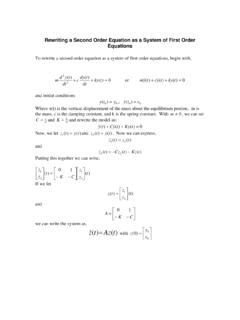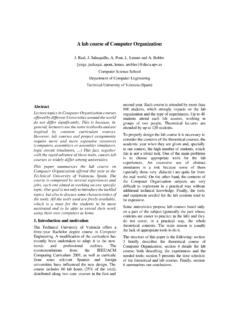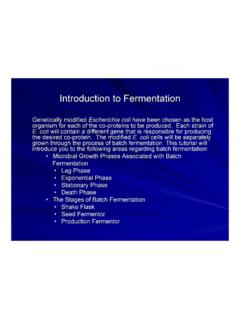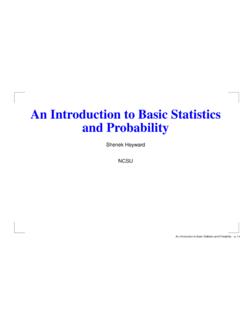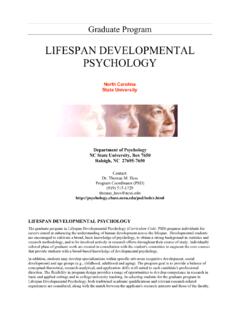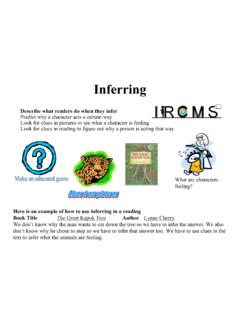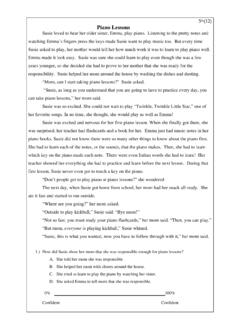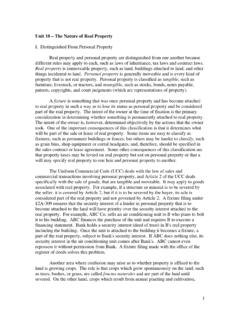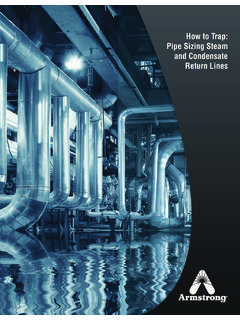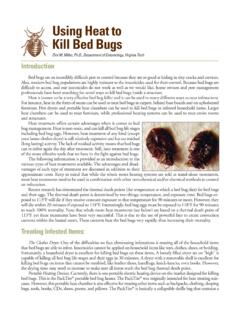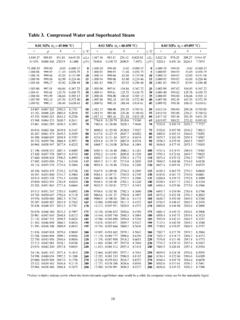Transcription of Mass and Energy Balances - NCSU
1 Mass and Energy Balances Outline Terminology Specific heat, enthalpy, heat, sensible heat, latent heat, saturation temperature & pressure, saturated liquid & vapor Phase diagram of water (liquid and vapor phases). Sub-cooled liquid, condensate, steam (saturated steam : mix of condensate & vapor), vapor, superheated steam steam table steam quality Superheated steam Energy content (or enthalpy). Liquid products, steam Mass and Energy Balances Batch & continuous processes (mixing & heating); direct & indirect contact heating; indirect contact cooling; determination of steam quality Terminology Specific heat (cp: J/kg K). Energy required to raise the temperature of unit mass of a substance by unit value It varies with temperature; however, for approximate calculations, cp of water is assumed to be 4180 J/kg K. Enthalpy (H: J/kg). Heat content of a system It is always expressed relative to a reference state (usually 0 C).
2 Generally, enthalpy is assumed to be zero at 0 C. For most liquids, H ~ cp (Tin C). Heat (Q: J). Energy transferred due to temperature difference between system and surroundings When Energy transferred is represented per unit time, its units are J/s or W. The Energy transferred may be utilized as sensible heat or latent heat Terminology (contd.). Sensible heat (Q: J or J/s). Energy transferred from hot to cold object For a batch system: Q = m cp T Q is in J.. For a continuous system: Q = m cp T Q is in J/s or W. Latent heat (Q: J or J/s). Energy transferred during phase change without any temperature change For a batch system: Q = m Q is in J.. For a continuous system: Q = m Q is in J/s or W. Latent heat of vaporization ( vap: J/kg). Energy reqd to convert 1 kg of a liquid to vapor phase w/o temperature change It equals Energy released when vapor condenses to liquid at that temperature For heating foods, the Energy of condensing steam is made use of Latent heat of vaporization of water at 100 C = kJ/kg Latent heat of fusion ( fus: J/kg).
3 Energy required to convert 1 kg of a solid to liquid phase w/o temperature change Latent heat of fusion of ice at 0 C = kJ/kg Terminology (contd.). Saturation temperature and pressure Any substance can exist in more than one phase at one time For any pressure, there is a temperature at which a liquid can coexist with the vapor phase This pressure and the corresponding temperature are called the saturation pressure and saturation temperature respectively Example: Water at kPa (atmospheric pressure) has a saturation temperature of 100 C. At higher pressure, saturation temperature is higher. Saturated liquid and saturated vapor When only liquid phase exists at the saturation pressure and temperature, the liquid is called saturated liquid or condensate (its enthalpy is denoted by Hc). When only vapor exists at the saturation pressure and temperature, the vapor is called saturated vapor (its enthalpy is denoted by Hv).
4 Phase Diagram of Water Within the dome, water exists as steam , Subcooled which is a mixture of Liq. + Vap. Pressure liq liquid and vapor. Liq. Vap. Here, temperature Saturated steam Superheated steam and pressure are constant and are called the saturation temperature and pressure respectively. Left of dome: Subcooled liq; Within dome: Saturated steam ; Right of dome: Superheated steam As we move from left to right within the dome, more and more of the water is in vapor phase. The fraction that is in vapor phase is called steam quality (denoted by x'). It varies from 0 to 1 OR 0% to 100%. Latent heat of vap. ( vap) at any temp. or pr. = Hv Hc at that temp. or pr. Saturated steam Table Temperature ( C). What is the latent heat of vaporization of water at atmospheric pressure? vap (at atm. Pr.) = Hv (at atm Pr.) Hc (at atm. Pr.) = = kJ/kg steam Quality (x). The term steam generally refers to saturated steam and not superheated steam steam is a mixture of liquid (condensate) and vapor The enthalpy of steam (Hs) is a weighted mean of enthalpy of condensate (Hc) and enthalpy of vapor (Hv).
5 Hs = x Hv + (1 x) Hc Rearranging, x = (Hs Hc)/(Hv Hc). Note that x = 0 when Hs = Hc Also, x = 1 when Hs = Hv Higher the steam quality, higher the value of Hs 0 x 1 OR 0% x 100%. Note: Hc & Hv at saturation temperature & pressure are determined from steam tables Superheated steam When the temperature of vapor is greater than the saturation temperature (at its saturation pressure), the steam is referred to as superheated steam The difference between steam temperature and saturation temperature is the degree of superheat Superheated steam at a given pressure can have different temperatures greater than the saturation temperature (unlike saturated steam ). Thus, to define the state of superheated steam , one has to specify the temperature and pressure To define the state of saturated steam one has to specify either temperature or pressure Q versus T. S: Solid (ice) V. L: Liquid (water) L to V.
6 100. V: Vapor (superheated steam ). Latent T (Temperature in C). L+V: Saturated steam L. Q1 = fusion(ice) = kJ/kg S to L. S Q2 = cp(water) T = kJ/kg 0. Latent Q3 = vap(water) = kJ/kg Q1 Q2 Q3. Q ( Energy Supplied). Energy Content Thermal Energy content of a solid or liquid: m cp (TKelvin - 273) OR m cp (TCelsius - 0). This is based on the assumption that the Energy content of the substance is zero at 0 C (= 273 K). Thermal Energy content (or enthalpy) of steam is given by: ms (Hs) Note: Hs = x (Hv) + (1 - x) Hc Heat Exchanger (HX). Equipment where heat is exchanged between two products steam losing heat and cold product gaining heat Hot water losing heat and cold product gaining heat Cold water gaining heat and hot product losing heat They may be batch or continuous & direct or indirect contact Batch heating: Home microwave oven Continuous heating: Pumping a product through a tube and heating it by steam or hot water from outside Direct contact heat exchanger Batch heating: Mixing steam with milk in the making of cappuccino Continuous heating: steam injection/infusion for a flowing product Indirect contact heat exchanger Batch heating: Retorts (for canning).
7 Continuous heating: Retorts (canning), double tube, plate, shell & tube Direct and Indirect Contact Heat Exchanger Direct contact heat exchanger steam contacts product and mixes with it steam loses Energy as it condenses; product gains Energy Rapid heat transfer; however, product is diluted Vacuum may be used to remove added water Indirect contact heat exchanger (eg. concentric metal pipes). steam is separated from product by a barrier (metal pipe). Not as much or as rapid heating; however, product is not diluted Energy transferred by steam to a product in a direct contact heat exchanger is given by: ms (Hs). Energy transferred by steam (when steam condenses completely) to a product in an indirect contact heat exchanger is given by: ms (Hs - Hc). Mass Balance Overall mass balance For any system, the total mass going into the system must equal the total mass coming out of the system plus any accumulation of mass in the system Batch system: mass (m) in kg.
8 Continuous system: mass flow rate (m) in kg/s Component mass balance For any component in a system, the total mass of that component going into the system must equal the total mass of that component coming out of the system plus any accumulation of that component in the system For any system (or sub-system), the number of mass balance equations = the number of components in the product One mass balance equation can be written for each component Energy Balance Energy balance For any system, the Energy going into the system must equal the Energy coming out of the system plus any accumulation of Energy in the system Only ONE Energy balance equation is written for any system (or sub-system) irrespective of the number of components in the product(s). Note: Once mass and Energy balance equations are written, make sure that the number of equations and number of unknowns are equal Applications of Mass and Energy Balance Mixing and/or separation of streams of products with different compositions Condensation of steam outside a tube through which product flows (indirect contact heating).
9 Mixing of steam with a product (direct contact heating). Direct contact heating is faster than indirect contact heating Side-effect of direct contact heating is dilution of product Vacuum may be used to evaporate water that was added Evaporation of water from a product to concentrate it Note: For batch systems, the term mass (m) is used and for continuous .. systems, the term mass flow rate (m) is used m: kg m: kg/s Mixing of Two Products in a Batch System (at the same temperature). m1, x1 Mixer m3, x3. m1, m2, m3: Total masses x1, x2, x3: Solid fractions m2, x2. The overall mass balance equation is : m1 + m2 = m3. The total solids balance equation is : m1 x1 + m2 x2 = m3 x3. The total water balance equation is : m1 (1-x1) + m2 (1-x2) = m3 (1-x3). The total water balance equation is however NOT a totally new equation. It can be obtained by subtracting the total solids balance equation from the overall mass balance equation.
10 Thus, there are only TWO equations for the above system. Hence, given any 4. variables in the system, the other 2 variables can be determined (Note that the 6. variables in the above system are m1, m2, m3, x1, x2, x3). Also note that in a system such as the one shown above, x1 + x2 x3. Mixing of Two Products in a Batch System (at different temperatures). cp(3), T3. m1, x1 Mixer m3, x3. cp(1), T1 m1, m2, m3: Total masses x1, x2, x3: Solid fractions cp(2), T2 m2, x2 cp(1), cp(2), cp(3): Specific heats T1, T2, T3: Temperatures Mass balance equations are the same as before Energy balance (when temperatures are in Kelvin): m1 {cp(1)}(T1 - 273) + m2 {cp(2)} (T2 - 273) = m3 {cp(3)} (T3 - 273). Energy balance (when temperatures are in Celsius): m1 {cp(1)}(T1) + m2 {cp(2)} (T2) = m3 {cp(3)} (T3). cp(1) = x1 cp(s) + (1 x1) cp(w). cp(s): Specific heat of solids cp(2) = x2 cp(s) + (1 x2) cp(w).
